Throughout the majority of Dragon Ball, very few obvious examples of family names (or “last names”) are given. For the most part, each character is introduced by and exclusively known by a single, given name. What few family names do exist are oftentimes explicitly cited by the characters themselves (e.g., “Son Goku”). Despite this, and perhaps conflated by various international editions, confusion does arise over certain names and whether they are to be interpreted as given or family names.
Within this guide, we at Kanzenshuu have attempted to document each and every example of a possible family name, and/or names that have provided enough confusion — either within the series itself or due to international editions — to warrant deeper exploration. Each name is ultimately broken down into one of three possible categories:
 Either explicitly confirmed to be or, given the surrounding evidence and context, almost certainly a true family name
Either explicitly confirmed to be or, given the surrounding evidence and context, almost certainly a true family name No explicit confirmation available, and/or enough contradictory or missing context to definitively answer one way or the other.
No explicit confirmation available, and/or enough contradictory or missing context to definitively answer one way or the other. Either explicitly confirmed not to be, or almost certainly, not a true family name.
Either explicitly confirmed not to be, or almost certainly, not a true family name.A few notes about family names in “the real world” and how this may relate to names in the Dragon World:
- In many cultures, calling a person solely by their family name may range anywhere from extremely formal to personal and endearing.
- In popular media, many characters are introduced as and near-exclusively referred to by their family name. See: Fry and Leela (Philip J. Fry and Turanga Leela, Futurama), Giles (Rupert Giles, Buffy the Vampire Slayer), House (Dr. Gregory House, House), Snape and Dumbledore (Severus Snape and Albus Dumbledore, Harry Potter), etc.
- While many names from foreign languages/countries are often “reversed” into given/family order in English-language publications, some exceptions to this rule do exist. For example, Korean names are kept in family/given name order. Likewise, historical figures — including those from Japan — are traditionally written in English with the original family/given name order where applicable.
- In line with the above point, certain cultures and languages may hyphenate a name in a way to provide distinction for a “middle” name or to separate syllables within a standard given name. With Dragon Ball occasionally and somewhat inconsistently borrowing from other cultures, this makes certain calls on given vs. family names incredibly difficult.
The In-Universe Family Name Explanation
In chapter 425 of the Dragon Ball manga, Videl has cleverly unmasked Gohan as the Great Saiyaman, and explains to Gohan that she has deduced this based on Gohan having the same family name — “Son” — as a previous winner of the Tenka’ichi Budōkai, Son Goku. Videl goes on to explain that, “[t]hese days it’s rare” to have a family name separate from the given name, which made the “Son” connection all the more obvious.


VIDEL: He had the same family name as you, didn’t he? These days it’s rare to have a name split in to a family name and personal name… I think that man “Son Goku” is probably your dad… Well?
GOHAN: U-umm… well… Man, this girl’s sharp!
— Dragon Ball chapter 425
Videl lives in the western part of the world, so it may be that family names were at one point in time common or at least slightly more in use. Akira Toriyama’s 2013 manga series (and Dragon Ball prequel) Jaco the Galactic Patrolman largely takes place in the eastern part of the Dragon World, where several characters do in fact have family names (some provided in the chapters themselves, and others in supplemental pages in the series’ collected edition). In the series’ sixth chapter, Omori responds to Tights’ name by noting it as sounding like a name from the western region; Tights responds that she is indeed from West City.

OMORI: Tights? That sounds like a name from the western region.
TIGHTS: That’s right. I’m from West City.
— Jaco the Galactic Pastrolman, chapter 6
As a general trend, character names written in katakana with the ・ interpunct (中黒; nakaguro or “middle black”) seem to infer a western name order (given name followed by family name). This obviously excludes names where a title or prefix is written first, such as the ミスター (Misutā or “Mister”) in “Mister Satan” and “Mister Popo”. The interpunct will heavily play into some of the explanations below.
A Note About International Editions
Significant misunderstandings arise due to various international translations and adaptations of the series. The French translation has a rich history of combining Goku’s full name into “Sangoku”. FUNimation’s English dub mistakes given names for family names (“Bulma Briefs”), and occasionally makes up entirely new names for otherwise unnamed characters (e.g., “Jimmy Firecracker” for the Cell Games television broadcast announcer). Early scripts for the 2009 live action film Dragon Ball Evolution — as well as the “Junior Novel” and the PlayStation Portable video game! — fabricate new family names for Bulma (“Enchanto”) and Chi-Chi (“McRoberts”).

These names and decisions hold no weight, and will not be considered or further referenced in the individual explanations and conclusions provided below.
Pre-Dragon Ball
 Proposed Family Names: 則巻 (Norimaki), 空豆 (Soramame), 摘 (Tsun), 山吹 (Yamabuki), etc.
Proposed Family Names: 則巻 (Norimaki), 空豆 (Soramame), 摘 (Tsun), 山吹 (Yamabuki), etc.Status: Yes
Throughout Akira Toriyama’s Dr. Slump, most human beings have traditional names with both a given and family name, beginning with the titular “Dr. Slump” himself, Senbei Norimaki. This surname is handed down to his robot creation Arale, and is later taken by his wife Midori (née Midori Yamabuki) and their son Turbo.

While making cameos in the Dragon Ball series, and particularly in a special episode of the Dragon Ball Super television series (episode 69), the Dr. Slump characters appear to keep their full given and family names where applicable.

A notable curiosity in the given/family name debate from Dr. Slump would be Senbei’s arch-rival Dr. Mashirito, who is not given any other names (other than perhaps his Caramel Men number assignments when he turns himself into a cyborg). As Mashirito comes from the Dr. Slump universe rather than the Dragon Ball universe, it is possible that “Mashirito” could be either a given or a family name… but read on for more on the various doctors later in this guide!
Known Families and Their Potential Family Names
The Son(?) Family
 Proposed Family Name: 孫 (Son)
Proposed Family Name: 孫 (Son)Status: Yes
In the very first chapter of Dragon Ball, the male protagonist introduces himself to the female protagonist as “Goku” with a direct follow-up to that: his full name is “Son Goku”. In typical Japanese fashion, the family name here comes first (“Son”) followed by the given name (“Goku”). While in Dragon Ball “Son” is a family name that Goku inherits from his adoptive grandfather Gohan, this is a fairly obvious example of a true family name within the series.

The name has a larger meaning and relevance out-of-universe, being the standard Japanese reading of the main character’s name — “Sun Wu-k’ung” — from the 16th century Chinese tale Journey to the West. In the original story, the “handsome monkey king” begins training with his first real master, the Taoist monk Subodhi. To earn his favor, the monkey inquires about receiving a new name.
The Patriarch laughed and said, “Though your features are not the most attractive, you do resemble a monkey (hu-sun) that feeds on pine seeds. This gives me the idea of deriving your surname from your appearance. I intended to call you by the name ‘Hu.’ Now, when the accompanying animal radical is dropped from this word, what’s left is a compound made up of the two characters, ku and yüeh. Ku means aged and yüeh means female, but an aged female cannot reproduce. Therefore, it is better to give you the surname of ‘Sun’. When the accompanying radical is dropped from this word, we have the compound of tzŭ and hsi. Tzŭ means a boy and hsi means a baby, so that the name exactly accords with the Doctrine of the Baby. So your surname will be ‘Sun’.” When the Monkey King heard this, he was filled with delight. “Splendid! Splendid!” he cried, kowtowing. “At least I know my surname. May the Master be even more gracious! Since I have receive the surname, let me be given also a personal name, so that it may facilitate your calling and commanding me.” The Patriarch said, “Within my tradition are twelve characters which have been used to name the pupils according to their divisions. You are one who belongs to the tenth generation.” “Which twelve characters are they?” asked the Monkey King. The Patriarch said, “They are: wide (kuang), great (ta), wise (chih), intelligence (hui), true (chên), conforming (ju), nature (hsing), sea (hai), sharp (ying), wake-to (wu), complete (yüan), and awakening (chüeh). Your rank falls precisely on the word ‘wake-to’ (wu). You will hence be given the religious name ‘Wake-to-Vacuity’ (wu-k’ung). All right?” “Splendid! Splendid!” said the Monkey King, laughing: “henceforth I shall be called Sun Wu-k’ung.”
— Journey to the West (original Anthony C. Yu translation, volume 1, chapter 1)

While the name “Son Goku” is directly taken from Journey to the West — as it is in other Japanese re-tellings, embellishments, and adaptations of the same original story — here in Dragon Ball it is presented as a standard, normal family name belonging to an old man that then passes it down to his adopted grandchild.

Goku’s two children — Gohan and Goten — take on the “Son” family name, and are actively referred to as “Son Gohan” and “Son Goten” throughout the series. In chapter 518, Goten appears in a shirt that reads as a western-order, transliterated “Goten Son”:

There is no evidence or documentation for Chi-Chi (Goku’s wife), Videl (Gohan’s wife), or Pan (Goku’s granddaughter; Gohan’s daughter) taking on this family name. The Dragon Ball GT special showcases a home labeled with the “Son” family name, but even here Pan is never given this name. “Son Goku Jr.” is specifically noted as having been given said name in memory of the original Son Goku, however.

The Brief(?) Family
 Proposed Family Name: ブリーフ (Burīfu)
Proposed Family Name: ブリーフ (Burīfu)Status: No
In chapter 68, Goku visits West City in an attempt to find Bulma. After an encounter with thugs and help from a young lady, Goku is finally pointed toward a police officer for directions. Goku asks if he knows where Bulma’s house is, but the policeman needs a better description. Goku draws a picture, but this is not quite what he had in mind. The policeman then pulls up the entries for “Bulma” on his computer, noting that it should not take long since it is an unusual name. While the first entry is not who Goku is looking for, the second entry is indeed his friend (not to mention the daughter of the Capsule Corporation owner!). One would think that if the police officer needed to narrow down the search, he would have specifically asked for a family name; not only was a family name not necessary, but the entries appear to show only single, given names.


Bulma’s father is referred to as Dr. Brief (ブリーフ博士; Buriifu Hakase), while Bulma’s mother is only ever referred to in the series (and supplemental material) simply as “Bulma’s mother” (ブルマの母; buruma no haha); she is never referred to as, for example, “Mrs. Brief” all on her own. In the 2004 Dragon Ball Forever guide book, Toriyama realizes this lack of a name and proposes a given name for Bulma’s mother:

Now that you mention it, she didn’t have a name, did she? Supposing I did name her, I would have probably used “Panchy”. Not “Panty”.
— Akira Toriyama, Dragon Ball Forever (p. 158)
There is one example that uses English text to refer to “Mrs. Brief”: the theatrical attendee booklet for the 2013 film Dragon Ball Z: Battle of Gods. All of the film’s characters are given short profiles, with “English” names being listed alongside the original Japanese text. For their section, Bulma’s parents are listed in Japanese as ブリーフ夫妻 (buriifu fusai), with the characters for “husband” and “wife” placed alongside each other. This is a fairly standard way of indicating a couple by name, similar to a formal “Mr. and Mrs. John Smith”. In fact, the English “translation” alongside this text does indeed write out “Mr. and Mrs. Brief”.


With this being the only instance of a “Mrs. Brief” specifically written in the Latin alphabet, and with the Japanese text clearly referring to the marital status, this can likely be ignored. This is similar in many ways to how Freeza and his father are referred to in the series as フリーザ親子 (Furiiza oyako, literally “Freeza parent and child”); the relationship is what is being stated by the additional text, rather than any specific name being given.
As covered earlier, Bulma’s sister Tights is later introduced in the 2013 series Jaco the Galactic Patrolman, and is likewise never referred to with a family name.

With Bulma’s family living in the western part of the Dragon World where Videl specifies that family names are not common, and with none of her family members ever actually referred to with a family name, we can assume that Dr. Brief is simply a man with the given name “Brief” that became a well-educated scientist.
In Dragon Ball Super episode 73, Bulma is referred to as ブルマ博士 (Buruma Hakase or “Dr. Bulma”) in the same style as her father. This seems to back up the idea that they are being referred to as their given name (i.e., the only name that they have!).
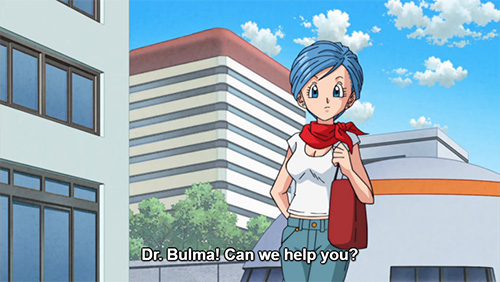
Other “doctors” throughout the franchise — Frappe, Kochin, Uiro, Gero, Lychee, Mu, etc. — are likely named in the same fashion.
The Vegeta(?) Family
 Proposed Family Name: ベジータ (Bejiita)
Proposed Family Name: ベジータ (Bejiita)Status: No
There is little-to-no evidence to suggest that “Vegeta” is anything other than a given name, albeit one that may be bestowed upon a planet in addition to actual progeny.

Daizenshuu 3 makes a note about the Saiyan class system with a minor callout to the “Vegeta” name:
The name Vegeta is a symbol of might and political power!
The royal house of Vegeta stands at the summit of Saiyan political power!! It is established that below the royal family are noble families of elite warriors such as Nappa, and then below that are low-level warriors. Incidentally, it seems that the establishment of the royal family was immediately after the massacre of the Tsufruians. The original king was Vegeta’s father, King Vegeta, and there is a hereditary system where the king’s child afterward inherits kingship!!
— Dragon Ball Daizenshuu 3, “TV Animation Part 1” (p. 122)
The 2018 theatrical film Dragon Ball Super: Broly establishes that the surviving Vegeta is “Vegeta the Fourth”, with no other clarification or qualification on the matter.
Toriyama himself gives a concrete answer to the matter in response to a fan question printed in the debut January 2003 issue of Viz’s Shonen Jump print magazine, confirming that Vegeta has no family name:
Do any of the characters have family names? –Cora “Chi-Chi” Warden, New York
Some do, some don’t. For example, “Son” is Son Goku’s family name, but Vegeta doesn’t have a family name.
The Money(?) Family
 Proposed Family Name: マネー (Manē)
Proposed Family Name: マネー (Manē)Status: Yes
The “Money” family appears exclusively in the ninth Dragon Ball Z film as the sponsors of the Tenka’ichi Dai-Budōkai.

The characters’ names are referenced inconsistently throughout various merchandise and documentation. The father’s and child’s names are the only two of three spoken aloud in the film, and the ending credits do not supply spellings (and therefore even voice credits) for any of the family members.
The film’s theatrical program book features a series of “Character Catalog” columns. Here, the members of the “Money Family” (マネー一家 Manē-ikka) each have their own (presumably) given name followed by the family name which is separated by an interpunct. As with other names written in this fashion, the punctuation seems to separate the given name and family name written here in western order.

- The father’s name — ギョーサン (Gyōsan) — means “a lot”
- The wife’s name — オッカネー (Okkanē) — comes from お金 (okane) meaning “money”
- The son’s name — ドル (Doru) — is the word “dollar” in Japanese
The “Library of Adventure” section in Daizenshuu 6 provides designs for all three characters, explicitly calling them the “Money Family” yet again. However, the characters’ given names are the only names actually written out alongside each character:

Additional merchandise tends to be comprehensive in their naming schemes, such as this Carddass card writing out the father’s name in full as 主催者 ギョーサン・マネー (Shusai-sha Gyōsan Manē or “[Tournament] Organizer Gyōsan Money”).

With the particular spelling pattern and consistent phrasing surrounding the family’s name, it is likely that “Money” is indeed the shared family name among all three members.
The Je(?) and Shi(?) Families
 Proposed Family Name: ジェ (Je) and シー (Shī)
Proposed Family Name: ジェ (Je) and シー (Shī)Status: Inconclusive
In Dragon Ball episode 79, Goku is recruited to help defend a village against two thugs who have been holding the villagers hostage by way of required monthly tributes of food. The thugs themselves, Ginkaku and Kinkaku, are direct references to Journey to the West characters of the same names (Silver Horn and Golden Horn), with a similar setup of a gourd that can absorb someone depending on whether or not they respond to their name.
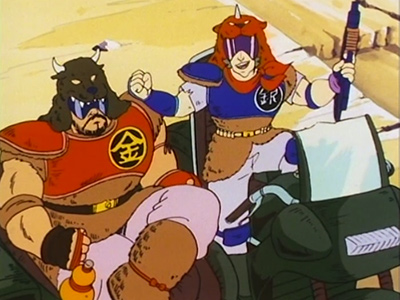
The young girl who recruits Goku is only credited and named aloud as “Chao” during the episode, and her father is likewise only credited as “Chao’s Father”. Other credited characters include “Burka” (named aloud in the episode), the “Village Headman”, and the nebulous “Villager” and “Boy” characters.

As Ginkaku and Kinkaku take roll, the crowd of villagers include “Burka”, “Sari”, “Pino”, “Huang”, “Chao”, and “Temujin”, followed by “Lian Jie”, “Ho Jie”, “Hu Jie”, and finally a baby (only born two weeks ago, and therefore unable to respond), “Chen Shih”. This names are rendered in the episode’s closed captions as:
- Lian Jie: リアン・ジェ (Rian Je)
- Ho Jie: ホー・ジェ (Hō Je)
- Hu Jie: フゥ・ジェ (Fū Je)
- Chen Shih: チェン・シー (Chen Shī)
Some of these names may be references to Chinese and wuxia film industry legends of the era: Jet Li’s real name is Li Lianjie, while Chen Shih Wei is an accomplished action director and actor. Meanwhile, others may be references to Chinese leaders and warlords: Temujin was Genghis Khan’s name, Chao may be a reference to Ma Chao, and Huang may be a reference to Qin Shi Huang.
In addition to the interpunct, the shared “Je” across three names — under other conditions in the series — would seem to imply a family name. On the other hand, the non-Japanese (all perhaps Chinese?) sources may all just be cute references intended as given names.
The Chin(?) Family
 Proposed Family Name: 陳 (Chin)
Proposed Family Name: 陳 (Chin)Status: Very Likely
During his training and journeys leading up to the 22nd Tenka’ichi Budōkai, in Dragon Ball episode 80 Goku learns of and meets a strong martial artist named “Chin Taiken”. The man has a young son named “Shōken”; 大拳 (taiken) means “big fist” while 小拳 (shōken) means “little fist”.

In one instance during the episode, rival martial artist Tenlong refers to the father by his presumed given name of just “Taiken”. A sign above the door at the family’s dōjō reads as 陳家星極拳法 (Chin-ka Seikyoku Kenpō, “Chin Family Star-Extremities Martial Arts”). There is an actual martial art called the “Eight Extremities” style; the name of the Chin family’s martial art appears to be a pun on that and the word kyoku-sei, or “pole star”.

The father and son are listed in the episode’s credits with just their given names of 大拳 and 小拳, respectively:
Daizenshuu 3, however, showcases both the father and son labeled with their full names:

Being a father/son duo with a pseudo-Chinese name (which would be read as “Chén”) shared between them in eastern order, it is very likely that “Chin” is indeed their family name.
The Hyōga(?) Family
 Proposed Family Name: 豹牙 (Hyōga)
Proposed Family Name: 豹牙 (Hyōga)Status: Inconclusive
In Dragon Ball episode 80, Goku comes across two fighters: a large drunkard named Shaolong and the thinner, more-reserved Tenlong. Goku is able to easily handle Shaolong’s attacks, though Tenlong puts up a more difficult fight. Goku finds himself up against Tenlong a second time as he takes the place as a competitor for the Chin family in a special tournament.
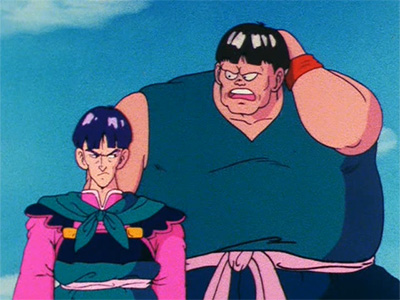
Both Taiken and Shōken speak Tenlong’s name aloud as a full “Hyōga Tenlong”, while Tenlong refers to his brother exclusively by his presumed given name “Shaolong”. The fighter’s style is said to be of the “Hyōga School”. 豹牙 (hyōga) means “leopard-fang”, while 天龍 (tenron) means “heavenly dragon” and 昇龍 (shaoron) means “rising dragon”. The characters’ names are written with furigana indicating a pseudo-Chinese pronunciation rather than the standard Japanese pronunciation (which would be “Tenryū” and “Shōryū”, respectively).
The characters are listed in the episode credits simply as 天龍 and 昇龍:
Daizenshuu 3 lists the characters exclusively by the same presumed given names, with the only reference to “Hyōga” being that of the “Hyōga School/Style” (豹牙流):

While the Chin family members do address Tenlong as a “complete” name of “Hyōga Tenlong”, there is precedent in referring to someone this way as part of the group they are associated with. For example, it is a common way of referring to Japanese comedians who are primarily associated with a comedy duo or troupe, or musicians who are primarily associated with a particular band.
With no spoken or written documentation placing “Hyōga” as a common name between the two characters, it may best be inferred that “Hyōga” is intended to be the name of the fighting style Tenlong has mastered. Were it to be a family name, Daizenshuu 3 likely would have made this as explicit as they did with the “Chin” family from the same episode.
The One-Off Examples
Toninjinka
 Proposed Family Name: 兎 (To)
Proposed Family Name: 兎 (To)Status: Maybe…?
This example is specific to the manga due to its written visual cues. In chapter 16, Yamcha watches from afar as the rabbit boss comes across the rest of the gang. Upon realizing who he is, Yamcha blurts out, “He’s To! Toninjinka!” In the written dialog, the “To” is not only first referenced separate from the name, but in the final part of the statement there is a space provided between the “To” (兎) and the “Ninjinka” (人参化).

The joke here is that the kanji being read as “To” — 兎 — is in fact the kanji for “rabbit” (typically read elsewhere as usagi), while the rest of the name describes how he turns people (人, here read as nin) into “carrots” (にんじん ninjin); Viz adapts this name as “Carrot Master” in their English translation of the manga while here at Kanzenshuu we adapt this as “Carrotizer Bunny”.

The fact that Yamcha seems to separate out a name and then the full name is written with a space between characters seems to suggest… well, something.
Tao Pai-pai
 Proposed Family Name: 桃 (Tao)
Proposed Family Name: 桃 (Tao)Status: Maybe…?
Called in by the Red Ribbon Army as a last resort, Tao Pai-pai begins the subgroup of vaguely-Chinese-sounding names while also still falling in line with the color scheme in use by the army: 桃 (indicated with a Chinese reading of “Tao”) meaning “peach”, and 白 (indicated with a pseudo-Chinese reading of “pai”) meaning “white”.

Tsuru-sen’nin, the Crane Hermit, has referred to his brother as “Pai-pai”:
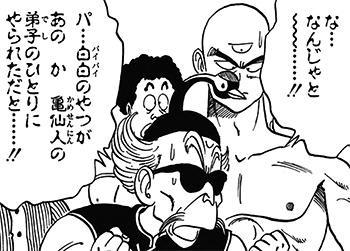
Following his defecting from the crane style, Tenshinhan refers to Tao Pai-pai once simply as “Pai-pai-san” at the 23rd Tenka’ichi Budōkai (though in their fight itself, he reverts back to a full “Tao Pai-pai-sama“):

The odd thing about Tenshinhan referring to him as “Pai-pai” is that, assuming this is a pseudo-Chinese name in eastern order and Tenshinhan is offering up the standard amount of respect, this would assume that “Pai-pai” is the family name while “Tao” is the given name. That being said, Tenshinhan has renounced his prior ways, and this may play into the way he refers to his prior mentor, even with the continued use of honorifics.
Tao Pai-pai is a name where we do not have a clear answer. The name is typically transliterated in Japanese reference material without spacing (as “Taopaipai”), and we have examples of different characters referring to him with the complete name and just as “Pai-pai”, all of which should otherwise be self-consistent but are not.
Tenshinhan
 Proposed Family Name: 天 (Ten)
Proposed Family Name: 天 (Ten)Status: Maybe…?
Tenshinhan (天津飯) and Chiaotzu (餃子) follow Tao Pai-pai in a string of pseudo-Chinese names for characters in the Red Ribbon Army arc and leading up to the 22nd Tenka’ichi Budōkai. The vast majority of characters refer to Tenshinhan by his complete name, though there are a few notable examples to the contrary.
Most obvious is perhaps Chiaotzu’s shortening — with the Japanese honorific — of “Ten-san“. The two characters are good friends and trained together, and there is a presumed familiarity that would not preclude them from referring to each other either by given or family names, rather than by the full name as a whole. The “-san” honorific is slightly unusual, not that he is using an honorific at all (see: Goten’s usage of “Trunks-kun” to Trunks’ usage of no honorific in return for Goten), but that he is using a respectful one here. Perhaps it is because he sees Tenshinhan as an elder brother figure, although we never find out exactly how old he is (and, indeed, he never seems to age)…
The Tenka’ichi Budōkai announcer has referred to him as 天津飯さん (“Tenshinhan-san” or “Mr. Tenshinhan”) as well as 天津飯選手 (Tenshinhan-senshu or “Competitor Tenshinhan”), in both cases using the “full” name of “Tenshinhan”:


The announcer has also referred to him as 天選手 (Ten-senshu, or “Competitor Ten”):
 |
 |
In this case, is the announcer using a shortened version of the character’s given name, or is he splitting out the given and family name? That multiple characters seemingly split the name seems to suggest… something. In the 21st Tenka’ichi Budōkai, the announcer establishes that he may refer to Goku as “Son-senshu“, which we know is using Goku’s family name. Meanwhile, he also uses “Jackie-senshu“… which only complicates things further.
Dragon Ball Super episode 89’s title refers to the 天津流道場 Tenshin-ryū Dōjō:

In the episode, Tenshinhan and his students wear the 天 (ten or “heaven”) symbol on their clothing, something Tenshinhan has done by himself in the past. All the meanwhile, Tenshinhan refers to his style as the 天流 (Ten-ryū) at the 天道場 (Ten Dōjō) within the episode’s script. From the standpoint of the original name pun, “Tenshin” refers to the Chinese city of “Tianjin”, which may be the thinking that led to the episode title; however, this makes less sense in the context of the character’s name, particularly with the way the three syllables in “Tenshinhan” and broken apart and recombined.
Things are further complicated by initial Weekly Shōnen Jump printings of the series, which included a space between the “Ten” and “shinhan” (as 天 津飯), which have been spaced back together in all subsequent reprintings. Furthermore, the furigana indicating the pronunciation was changed from てんしんはん in hiragana to テンシンハン in katakana (perhaps further emphasizing the “foreign”, faux-Chinese pronunciation):


Text adjustments were not limited just to Tenshinhan’s name, either: the 気功砲 (Kikōhō) was written differently in the Cell arc for its 新気巧砲 (Shin-Kikōhō) variant, which was “changed” back to 新気功砲 in the kanzenban re-release.
Tenshinhan’s name is one where we simply do not have a clear answer. Even ignoring the original spacing in his name, the various ways other characters address Tenshinhan and the faux-Chinese roots of the name complicate things too much to make any kind of judgment call.
Shū Sai’aku
 Proposed Family Name: 周 (Shū)
Proposed Family Name: 周 (Shū)Status: Likely
In episode 118 of the Dragon Ball Z television series, Chi-Chi hires a special tutor for Gohan named Shū Sai’aku. This horrible, abusive person is named with a presumed given name written with the kanji for “disaster” (災 or sai) and “evil” (悪 or aku), and the presumed family name of 周 (Shū). “Sai’aku” is a homonym for 最悪 meaning “(the) worst”, while 周 (Zhou in Chinese) is an actual Chinese family name.

The character is only named once in dialog during the episode — introduced as “Shū Sai’aku-sensei” by Chi-Chi — and is not listed in the episode’s credits. While the character’s origins are not discussed during the episode, if he is local to the Son family, he too may live in a region where family names are still used. Additionally, with 周 actually being a real family name, this could hold true for the Dragon Ball character as well. There is not much more to go on, but what little evidence there is seems to suggest a separate given and family name.
Rao Chuu
 Proposed Family Name: ラオ (Rao) or チュウ (Chuu)
Proposed Family Name: ラオ (Rao) or チュウ (Chuu)Status: Possible
In Dragon Ball Z episode 170 — a filler episode slotted in the days before the Cell Games — Son Gohan comes across a girl named Lime, whose parents were murdered by Cell as he wandered from town to town absorbing people. Lime has been taken in by an elderly man, who turns out to be a former martial artists that had even competed in the Tenka’ichi Budōkai at one point. The elderly man stands up to Bourbon, a criminal extorting the townspeople of their money and resources by promising them safety from Cell in a special dome he has constructed.

The elderly man is never referred to by name during the episode (Lime simply refers to him as jiichan or “gramps”), though the episode’s end credits provide a name of: ラオ・チュウ

The name is derived from 老酒 (lǎojiǔ), Chinese fermented alcohol, and in particular, Shaoxing wine; the kanji itself mean “old alcohol”. The Japanese approximation of this is ラオチュウ (raochuu), which is clearly where the character takes his name from.
The interpunct in the name yet again indicates some kind of intentional thought has been given to the name, though as with other names rooted in Chinese, this one is a difficult call.
Barry Carn
 Proposed Family Name: カーン (Kān)
Proposed Family Name: カーン (Kān)Status: Very Likely
In chapter 476, Barry Carn is shown and named in issue of Super Guy magazine (split into a separate given and family name in the Latin alphabet) as Boo comes across a frightened woman. Barry returns in Dragon Ball Super episodes 73 and 74, cast in the role of Great Saiyaman for a theatrical film.

The character’s name is a pun on バリカン (barikan), or “hair clippers”; its elongated vowel sound and punctuation separating it into given and family names works well here to frame him as a popular, western-esque actor. With his name being separated by punctuation in Japanese and fully transliterated in the manga as a separate “Barry” and “Carn”, it stands to reason that this is a clear given and family name distinction.
There is no indication, however, if “Barry Carn” is the character’s “real” name or simply a stage-name.
Cocoa Amaguri
 Proposed Family Name: 甘栗 (Amaguri)
Proposed Family Name: 甘栗 (Amaguri)Status: Very Likely
Alongside Barry Carn’s reappearance in Dragon Ball Super episodes 73 and 74, “popular idol” Cocoa Amaguri is introduced to play the love interest in the “Great Saiyaman vs. Mr. Satan” theatrical film.

Cocoa’s name is displayed on-screen in eastern order as 甘栗 ココア (Amaguri Kokoa). With her castmate sporting a likewise separate given and family name, independent of if these are “real” names or stage names, they should logically be assumed to be separate given and family names.
Mō Kekko
 Proposed Family Name: 猛 (Mō)
Proposed Family Name: 猛 (Mō)Status: Very Likely
In chapter 518, the various competitors for the 28th Tenka’ichi Budōkai are decided, with Pan set to go up against a martial artist whose name is written out in the tournament bracket as: 猛 血虎 (Mō Kekko), written with the kanji for “ferocious”, “blood”, and “tiger” (a suitable name for a large, mean-looking guy). The pun here is directly on the phrase of the same reading roughly meaning “I’m fine” or “No thank you”.

The announcer refers to the character as “Mō-senshu” (“Competitor Mō”), similar to “Son-senshu” where a family name is seemingly being used on purpose. Similar to the Toninjinka example, this character’s name has a space placed between what would presumably be the family name (Mō) and the given name (Kekko). In the same page listing the other competitors, Goku’s and Goten’s names are spaced out as 孫 悟空 and 孫 悟天 respectively. If Mō Kekko’s name is consistent with these, it would stand to reason that “Mō” is indeed intended to be his family name.
Baron Jaguar Batta
 Proposed Family Name: バッタ (Batta)
Proposed Family Name: バッタ (Batta)Status: Maybe…?
Baron Jaguar Batta is a character from the eleventh Dragon Ball Z theatrical film, and is responsible for creating an army of bio-engineered super-fighters (“Bio-Warriors”), including a clone of Broli.

The character’s name of ジャガー・バッタ男爵 (Jagā Batta Danshaku) comes from a series of puns, beginning with じゃがバター (jaga batā or “buttered potato”), as well as 男爵芋 (danshaku-imo, referring to the Irish cobbler potato). The ultimate joke is that danshaku is Japanese for “baron”, and so this character is an actual baron. His hideout — “Castle May Queen” — is named directly after the May Queen potato.
As an aside, the direct spelling of バッタ refers to “grasshopper” in Japanese, though that meaning has no relevance to this character. The name is also similar to that of Butta, one of the Ginyu Special Force members (whose name is spelled as バータ bāta, with an elongated-vowel sound rather than a doubled-consonant sound).
The character’s name is listed in the film’s credits as “Jagā Batta” (ジャガー・バッタ), written in katakana with the punctuation separating the presumed given and and family name:

However, the character design and profile from Daizenshuu 6 lists him as “Jaga Badda” (ジャガー・バッダ); it is unclear if this is a mistake or an intentional change.

The character’s name is transliterated as “Jaguar” in the 1995 Sega Saturn video game Dragon Ball Z: Shin Butōden, with the game’s special Mr. Satan mode’s fights taking place in the “Jaguar Dome”.
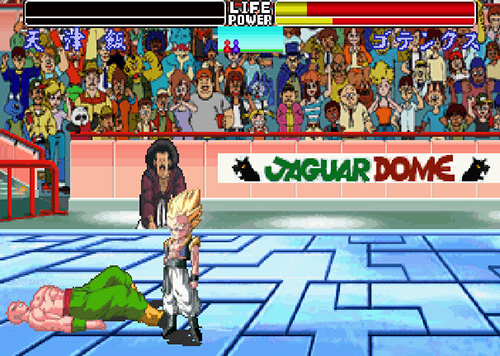
As with other names in this style, the katakana spelling and punctuation inferring a western name order likely means that “Batta” is the character’s family name, though the “Jaguar Dome” naming scheme is slightly curious.
Don Kiā
 Proposed Family Name: キアー (Kiā)
Proposed Family Name: キアー (Kiā)Status: Maybe…?
Don Kiā is introduced in the fourth Dragon Ball GT episode as a money-hungry tyrannical leader on Planet Imegga. In keeping with the planet’s money theme (itself a pun on gametsui or “greedy”), his name is a reversed 商人 (akindo meaning “merchant”).

In the episode credits, the character’s name is written out as: ドン・キアー

This punctuation alongside a katakana spelling tends to indicate a western name order, but in this case the “Don” part may refer — intentionally or otherwise — to the Spanish male honorific, in which case the character’s given name would be “Kiā” with no family name.
Mucchi Mocchi
 Proposed Family Name: ムッチー (Mutchī) or モッチー (Motchī)
Proposed Family Name: ムッチー (Mutchī) or モッチー (Motchī)Status: Very unlikely
Mucchi Mocchi is a villain introduced during the first arc of Dragon Ball GT, serving under Lood. His true identity is actually that of a shapeshifting whip simply named Mucchi; Mocchi was apparently nothing more than Mucchi’s servant. The two(ish) names come from 鞭 (muchi or “whip”) and 持ち (mochi or “carry”/”hold”).

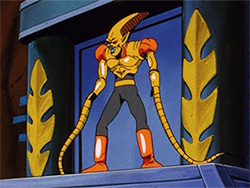
In his initial appearance, the “combination”-esque character (whip villain + henchman) is credited as ムッチー・モッチー (Mutchī Motchī); in his “true” form, the character is credited simply as ムッチー (Mutchī):
A name written in katakana with an interpunct tends to infer a given and family name written in western order, respectively. However, as the character later reveals himself with a completely different form (with his own individual name) and having been using another character (with his own individual name) as a henchman, we can assume that a “full” name of “Mucchi Mocchi” was more along the lines of a collective name for the two characters together.
Ebitchiri
 Proposed Family Name: リー (Lee)
Proposed Family Name: リー (Lee)Status: Possible
A competitor at the 31st Tenka’ichi Budōkai who ultimately gives up against Papayaman, Ebitchiri’s name is typically transliterated as such all as one continuous, single word; this is likely due to its probable pun source, エビチリ (ebi chiri, or “ebi chili”), a dish consisting of stir-fried shrimp in a spicy savory sauce.

The name is spoken aloud during Dragon Ball GT episode 41, and is written both in the closed captions for the episode as well as the end credits as エビッチ・リー (Ebitchi Rii).

As with other names, the interpunct seems to suggest separate given and family names; here, the リー could reasonably be adapted as “Lee”, a common family name.
Jaco Tilimentempibosshi
 Proposed Family Name: ティリメンテンピボッシ (Tilimentempibosshi)
Proposed Family Name: ティリメンテンピボッシ (Tilimentempibosshi)Status: Yes
Jaco is a “super-elite” member of the Galactic Patrol introduced as the titular character of Akira Toriyama’s 2013 manga series (and not-so-secret Dragon Ball prequel). Jaco later appears in the 2015 theatrical film Dragon Ball Z: Resurrection ‘F’ and as a recurring character in the Dragon Ball Super television series.

While Jaco is never referred to by his full name in dialog, the series’ collected edition provides extra pages with character sketches and biographies, with many of these profiles very clearly showcasing separate given and family names. Here, Jaco’s full name is listed as: ジャコ・ティリメンテンピボッシ (jako tirimentempibosshi). Jaco’s name is separated by punctuation in its katakana spelling, seeming to infer a western name order and separate given and family name. As such, “Tilimentempibosshi” is indeed likely his family name.
Ōmori Tokunoshin
 Proposed Family Name: 大盛 (Ōmori)
Proposed Family Name: 大盛 (Ōmori)Status: Yes
Ōmori is an elderly researcher and scientist introduced in Jaco the Galactic Patrolman. As described earlier, Ōmori comments to Tights regarding the unusual nature of her name as being in the western style. As such, it would stand to reason that Ōmori would have separate given and family names; his late wife’s gravestone solidifies this in the first chapter with its full name inscription of 大盛飯子 (Ōmori Mamako).

The collected edition of the manga explicitly details the scientist’s name as a full 大盛 徳之進 (Ōmori Tokunoshin).

As opposed to Jaco’s name written in katakana with punctuation separating the names, here the character’s name is written in kanji with a space separating the presumed family name (first) and given name (second). Beyond the obvious content from the series itself, the name’s full kanji spelling and specific spacing solidifies “Ōmori” as the family name.
Katayude Tamagorō
 Proposed Family Name: 固茹 (Katayude)
Proposed Family Name: 固茹 (Katayude)Status: Yes
Katayude is a divisional chief inspector with the Government Police Maritime Division, introduced in the second chapter of Jaco the Galactic Patrolman.

As with other characters, though his full name is not given in the series itself, it is provided in the series’ collected edition. Here, the character’s full name is listed as: 固茹 玉吾郎 (Katayude Tamagorō).

Similar to Ōmori’s name, here Katayude’s name is written in kanji with a space separating the presumed family name (first) and given name (second).
All members of Katayude’s special forces unit are given codenames in the spirit of edible seaweed (Hondawara, Hijiki, Aosa, and Mozuku), and all are presumed to have “real-life” given and family names separate from these.
Okawari Manpuku
 Proposed Family Name: 岡割 (Okawari)
Proposed Family Name: 岡割 (Okawari)Status: Yes
Okawari Manpuku is the captain of the spaceship “Twinkle 8” that intends to bring An Azuki into space, introduced in the eighth chapter of Jaco the Galactic Patrolman. As with other characters, though his full name is not given in the series itself, it is provided in the series’ collected edition. Here, the character’s full name is listed as: 岡割 満腹 (Okawari Manpuku).

Similar to Ōmori’s and Katayude’s names, here Okawari’s name is written in kanji with a space separating the presumed family name (first) and given name (second).
Azuki An
 Proposed Family Name: 亜月 (Azuki)
Proposed Family Name: 亜月 (Azuki)Status: Yes
Introduced by name in the first chapter of Jaco the Galactic Patrolman (and later actually shown), Azuki An is an idol singer set to take a trip to space aboard a rocket ship (though Tights was actually to serve as her body double). Unlike other characters in Jaco, her name is given in full right from the start: 亜月アン (Azuki An).

The character’s name is repeated in the collected edition’s series of character profiles, and similar to others is written with a space separating the presumed family name (first, written in kanji) and given name (second, written in katakana).

As a pop idol, this may actually be a stage name as opposed to her “real-life” name, but this is the only name given to her over the course of the series.
Otta Magetta
 Proposed Family Name: オッタ (Otta) or マゲッタ (Magetta)
Proposed Family Name: オッタ (Otta) or マゲッタ (Magetta)Status: Maybe…?
While the character is usually referred to simply as “Magetta”, the “full name” of “Otta Magetta” is introduced in episode 35 (and subsequently manga chapter 11) of the Dragon Ball Super series. In the television series’ closed captions as well as in the manga, the name is written with an interpunct as: オッタ・マゲッタ

The full name is likely a pun on the verb ottamageru, which means to be astounded or flabbergasted. At the same time, it is possible that “Magetta” in particular was influenced by the famous giant robots Mazinger (マジンガー majingā) and Getter Robo (ゲッターロボ gettā robo).
Though the interpunct seems to imply something, whether either “Otta” or “Magetta” represents a family name remains unclear, as we are not privy to the naming schemes within Universe 6 as a whole or specifically the “Metalmen” from Galactic System 66950.
Brianne de Chateau
 Proposed Family Name: シャトー (Shatō)
Proposed Family Name: シャトー (Shatō)Status: Inconclusive
Universe 2’s Brianne de Chateau (ブリアンデシャトー Buriandeshatō) is introduced in episode 91 of the Dragon Ball Super television series, and immediately showcases her magical transformation into Ribrianne (リブリアン Riburian).
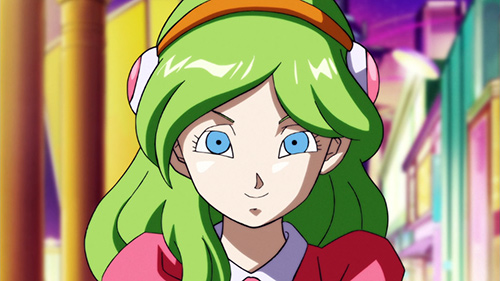
Both names are likely derived from Chateaubriand (シャトーブリアン shatōburian) steak, a French dish made with a thick cut of beef tenderloin filet. The character name is a rearrangement of the katakana used to write “Chateaubriand” in Japanese, with the inclusion of the French word “de”, meaning “of” or “from”. The steak dish is named for François-René de Chateaubriand, whose surname comes from the French town of the same name.

French names may include the word “de-” or “du-” or “de la-” as part of the family and/or estate name. Loosely following the French source of the name, it would be reasonable to then assume “Brianne” as the given name and “Chateau” as the family name… or it could just be a fancy name. In Japanese, the entire name is spelled out all as one “word”, leaving it rather ambiguous.
Sanka-Ku
 Proposed Family Name: クー (Kū)
Proposed Family Name: クー (Kū)Status: Inconclusive
Universe 2’s Sanka-Ku (サンカ・クー Sanka Kū) is introduced in the Dragon Ball Super series’ Tournament of Power. Like her Maiden Squadron teammates, she showcases her own magical transformation named Kakunsa (カクンサ Kakunsa).

The character’s names are likely derived from the Japanese term for chuck ribs (三角バラ sankaku bara), a cut of beef taken from the chuck area of cattle, characterized by its strong marbling.

In line with her teammates having names with separated portions, and with her own name featuring an interpunct directly separating them, it is possible that “Sanka” is the given name with “Ku” being the family name… or it could just be a fancy name.
Sue-Roas
 Proposed Family Name: ロース (Rōsu)
Proposed Family Name: ロース (Rōsu)Status: Inconclusive
Universe 2’s Sue-Roas (スー・ロース Sū Rōsu) is introduced in the Dragon Ball Super series’ Tournament of Power. Like her Maiden Squadron teammates, she showcases her own magical transformation named Rozie (ロージィ Rōjii).

The character’s names are likely derived from “roast” (ロース Rōsu). Taken from the English word “roast”, this converted Japanese term indicates lean cuts of meat from around the shoulder and back, typically referring to what is considered the loin or sirloin in traditional American cuts. In some cases, rōsu is translated as “loin”. The character name elongates the last vowel and appends a duplicate of the last syllables at the beginning of the name.
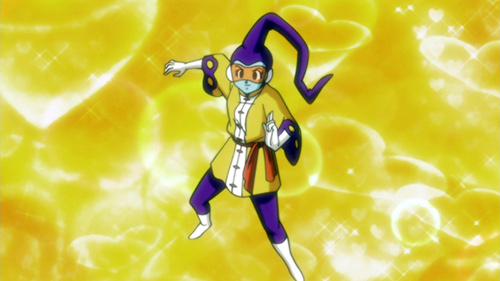
In line with her teammates having names with separated portions, and with her own name featuring an interpunct directly separating them, it is possible that “Sue” is the given name with “Roas” being the family name… or it could just be a fancy name.
Likely/Known Aliases
Jackie Chun
 Proposed Family Name: チュン (Chun)
Proposed Family Name: チュン (Chun)Status: Maybe…? But probably not…?
The turtle hermit goes under the alias “Jackie Chun” during the 21st Tenka’ichi Budōkai to compete against his pupils so as to have them not hold back or otherwise have any prior emotional attachment to the battles. While it is an alias, it is in fact broken up with punctuation (ジャッキー・チュン) as a distinct “Jackie” and “Chun”. As this name is a play on the real-life “Jackie Chan” (itself actually a stage name for the actor Chan Kong-sang), the logical assumption here would be to place “Jackie” as the given name and “Chun” as the family name.

Whether or not there is an “actual” Chun family in the Dragon World, or if this somewhat exotic-sounding name is something the turtle hermit came up with on his own… we may never know!
It is worth noting here that 亀仙人 (Kame-sen’nin or “Turtle Hermit”) and 武天老師 (Muten-Rōshi or “Invincible Old Master”) are themselves both descriptive titles, and not proper names.
… That being said, when he shows his driver’s license to Chi-Chi, she is apparently convinced of his identity. While no name is shown in the manga, the television series jumps to a shot displaying the title of “Muten-Rōshi” on the license.


In a bit of literally-related information, the turtle hermit’s sister is given the title of “Fortuneteller Crone” (占いババ Uranai Baba), which is likewise not an actual name.
Mr. Satan
 Proposed Family Name: サタン (Satan)
Proposed Family Name: サタン (Satan)Status: No
Mr. Satan is first introduced in the Cell arc of the series, and is a beloved fighter who won the 24th Tenka’ichi Budōkai. The character’s name is written as ミスター・サタン (Misutā Satan), with punctuation separating the “Mister” portion from the “Satan” portion, and is transliterated in our alphabet directly in the manga as “Mr. Satan”. Characters will often refer to him simply as “Satan”, while others will disregard the “Mr.” portion and append their own Japanese honorific, such as “Satan-san“.


With Videl stating that family names are not popular these days where she lives, it stands to reason that she and her father would not have a shared family name. Original author Akira Toriyama went on to fully detail the character’s name in supplemental material, assigning him a true given name and explicitly stating that he and Videl do not have a family name.

Since he’s a professional grappler, I used a name that would make him sound like one. Because this is his ring name, I think his actual name is probably something different.
— Akira Toriyama, Dragon Ball Forever (p. 158)
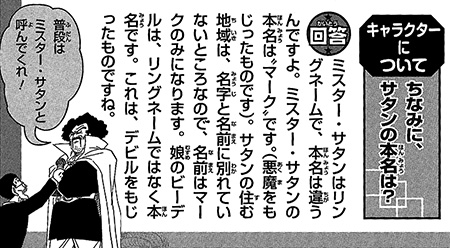
“Mister Satan” is a ring name, and his real name is different. Mister Satan’s real name is “Mark”. (this is a pun on akuma) In the region where Satan lives, family names aren’t separated from given names, making his name only “Mark”. His daughter “Videl” is not a ring name, but her real name. This is a pun on “devil”.
— Akira Toriyama, Super Exciting Guide: Character Volume (p. 91)
Toriyama says it best: his name is only “Mark”.
Great Saiyaman
 Proposed Family Name: None
Proposed Family Name: NoneStatus: No
Following the more-descriptive “Golden-Haired Warrior”, “Great Saiyaman” (グレートサイヤマン) is the next alias Gohan adopts to fight crime in the Boo arc of the series.

While it should be obvious due to the fact that viewers already know the character is Gohan, “Great” is simply taking the English word’s real meaning, “Saiya” comes from his racial heritage (half-Saiyan), and “man” is also taken from the English word’s real meaning.
Captain Chicken
 Proposed Family Name: チキン (Chicken)
Proposed Family Name: チキン (Chicken)Status: Probably not…?
Similar to the “Jackie Chun” example, “Captain Chicken” is likely an alias, and is broken up with punctuation (キャプテン・チキン) to separate the “Captain” and the “Chicken”.

While it is certainly possible for someone to have a given or family name of “Captain” as well as a given or family name of “Chicken” in the Dragon World… this is likely not the case with Captain Chicken.
Papayaman
 Proposed Family Name: None
Proposed Family Name: NoneStatus: No
“Papayaman” is the audience-known alias for Oob when he enters the 31st Tenka’ichi Budōkai in Dragon Ball GT episode 41.

While it should be obvious due to the fact that viewers already know the character is Oob, the “man” here is clearly the English word being used, similar to Gohan’s “Great Saiyaman” alias.
Additional Notes
- Chi-Chi, one of the earliest characters introduced in the series (and who later marries Goku), is written in Japanese as one singular name: チチ (Chichi). Her name is typically hyphenated into two parts in our alphabet to separate the two syllables a little more obviously. This is likely intended to be just a given name.
- Lan-Fan, one of the competitors at the 21st Tenka’ichi Budōkai, is written in Japanese as one singular name: ランファン (Ranfan). Her name is typically hyphenated into two parts in our alphabet to bring out the “lingerie” and “foundation” words that serve as her name source. This is likely intended to be just a given name.
- Otoko Suki, one of the competitors at the 28th Tenka’ichi Budōkai, is written in Japanese as one singular name: オトコスキー (Otokosukī). His name is typically separated into two “words” in our alphabet to bring out the underlying base (that he “likes boys”). This is likely intended to be just a given name.
- Maji-Kayo is a Tournament of Power competitor from Universe 3 in the Dragon Ball Super series whose name is written out in Japanese as マジ=カーヨ (Maji = kāyo), a play on the phrase roughly meaning “unbelievable”. With such an odd spelling, there is not enough information to make a call here.


